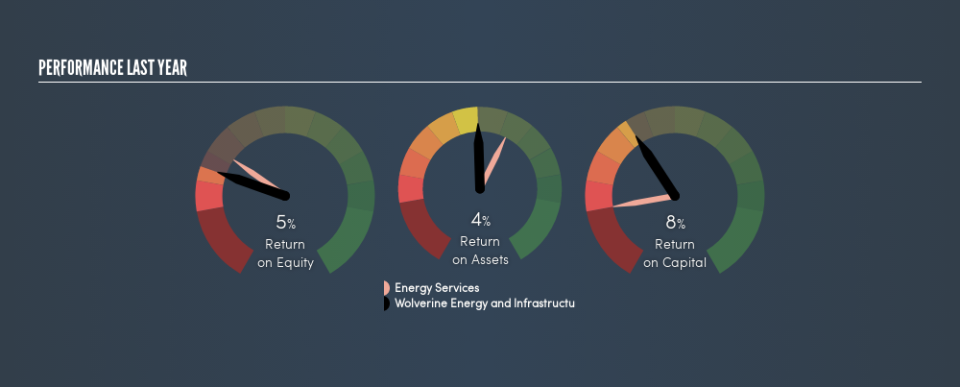Should You Like Wolverine Energy and Infrastructure Inc.’s (CVE:WEII) High Return On Capital Employed?

Today we'll evaluate Wolverine Energy and Infrastructure Inc. (CVE:WEII) to determine whether it could have potential as an investment idea. In particular, we'll consider its Return On Capital Employed (ROCE), as that can give us insight into how profitably the company is able to employ capital in its business.
First up, we'll look at what ROCE is and how we calculate it. Next, we'll compare it to others in its industry. Then we'll determine how its current liabilities are affecting its ROCE.
Return On Capital Employed (ROCE): What is it?
ROCE is a measure of a company's yearly pre-tax profit (its return), relative to the capital employed in the business. In general, businesses with a higher ROCE are usually better quality. Ultimately, it is a useful but imperfect metric. Author Edwin Whiting says to be careful when comparing the ROCE of different businesses, since 'No two businesses are exactly alike.'
So, How Do We Calculate ROCE?
Analysts use this formula to calculate return on capital employed:
Return on Capital Employed = Earnings Before Interest and Tax (EBIT) ÷ (Total Assets - Current Liabilities)
Or for Wolverine Energy and Infrastructure:
0.08 = CA$7.1m ÷ (CA$110m - CA$21m) (Based on the trailing twelve months to December 2018.)
Therefore, Wolverine Energy and Infrastructure has an ROCE of 8.0%.
Want to participate in a short research study? Help shape the future of investing tools and you could win a $250 gift card!
Check out our latest analysis for Wolverine Energy and Infrastructure
Is Wolverine Energy and Infrastructure's ROCE Good?
One way to assess ROCE is to compare similar companies. In our analysis, Wolverine Energy and Infrastructure's ROCE is meaningfully higher than the 6.4% average in the Energy Services industry. We consider this a positive sign, because it suggests it uses capital more efficiently than similar companies. Aside from the industry comparison, Wolverine Energy and Infrastructure's ROCE is mediocre in absolute terms, considering the risk of investing in stocks versus the safety of a bank account. Investors may wish to consider higher-performing investments.
When considering this metric, keep in mind that it is backwards looking, and not necessarily predictive. ROCE can be deceptive for cyclical businesses, as returns can look incredible in boom times, and terribly low in downturns. ROCE is only a point-in-time measure. Given the industry it operates in, Wolverine Energy and Infrastructure could be considered cyclical. Since the future is so important for investors, you should check out our free report on analyst forecasts for Wolverine Energy and Infrastructure.
What Are Current Liabilities, And How Do They Affect Wolverine Energy and Infrastructure's ROCE?
Liabilities, such as supplier bills and bank overdrafts, are referred to as current liabilities if they need to be paid within 12 months. Due to the way ROCE is calculated, a high level of current liabilities makes a company look as though it has less capital employed, and thus can (sometimes unfairly) boost the ROCE. To check the impact of this, we calculate if a company has high current liabilities relative to its total assets.
Wolverine Energy and Infrastructure has total assets of CA$110m and current liabilities of CA$21m. Therefore its current liabilities are equivalent to approximately 19% of its total assets. This very reasonable level of current liabilities would not boost the ROCE by much.
The Bottom Line On Wolverine Energy and Infrastructure's ROCE
If Wolverine Energy and Infrastructure continues to earn an uninspiring ROCE, there may be better places to invest. Of course, you might find a fantastic investment by looking at a few good candidates. So take a peek at this free list of companies with modest (or no) debt, trading on a P/E below 20.
I will like Wolverine Energy and Infrastructure better if I see some big insider buys. While we wait, check out this free list of growing companies with considerable, recent, insider buying.
We aim to bring you long-term focused research analysis driven by fundamental data. Note that our analysis may not factor in the latest price-sensitive company announcements or qualitative material.
If you spot an error that warrants correction, please contact the editor at editorial-team@simplywallst.com. This article by Simply Wall St is general in nature. It does not constitute a recommendation to buy or sell any stock, and does not take account of your objectives, or your financial situation. Simply Wall St has no position in the stocks mentioned. Thank you for reading.


